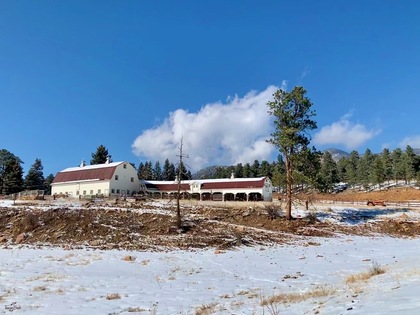
The Most Popular Horse Breeds Of 2019
Equestrian Advice & Guides General Equestrian
Build your business profile for FREE and expose your services to thousands of potential clients!
Create my profile now!
My favorite day of the year so far was autumn.
That’s about how long it lasted here in the Colorado Rocky Mountains; a day, and then winter settled in like an unwanted long-lost relative. Don’t get me wrong, I love winter! Nothing better than the crisp early mornings, the lack of bugs, flies, heat and traffic! But a single day of fall followed by temps in the twenties and below? No, thank you.
Why do us horse people dread winter? Surely it has nothing to do with frozen fingers, toes, or water troughs. Nah, that can’t be it, so maybe it’s the broken rakes, the eternal layering of clothing and the frost in our eyes and noses, or perhaps the snow balls in our horses’ feet that must be pried out so they can walk. And the ice…yes, let’s not forget the ice coating everything. So how do we prepare, endure and enjoy the cold, wet, white, wonderful winter with our horses?
Lists help. Money helps. With a list and money, you write it down and pay someone else to do it! Oh, not practical? Okay then, but what are the best and most tried and true ways to get everything done, while not suffering? And how do we keep our horses drinking, eating, warm and healthy?
The horses: Our equine companions do need a little extra care in the winter months, even in temperate climes, but especially in the northern areas of our planet. They are naturally fully-equipped for weather. For winter, they grow long, dense coats and they have no toes that turn blue, freeze and suffer frostbite. They can suffer frostbite, just not on their feet, generally, so as long as they have shelter, good hay and fresh water, they tend to do okay, though their nutritional needs do change.
*Hot topic: Blankets: Yes, some horses actually do need a little extra help during the coldest of months. The elderly, infirm, ill and young, especially; just like humans. It takes a lot for a warm-blooded body to maintain the perfect body temperature (Each horse is different, so know your horse’s norm!) The discussion over whether to blanket or not is a hot topic among horse people. Do the research and do what you want based on fact and experience, but know that there is no shame in whatever you choose.
Personally, I live at 8500 feet and our temps plummet to below freezing air that is often accompanied by snow, so yes, I blanket. My horses “tell me” that they want them or not, and I follow their wishes. I need a servant as good as me, no kidding! Just hold the blanket up and if the horse wants it, he puts his head through and if not, he walks away. Simple, just like me.
Feed: The short answer to the feed question is to up your hay rations on the coldest, wettest and windiest days. Feed more, but over a longer period of time by using hay bags, nets, or slow feeders. Feed grass hay and cut back on the alfalfa, because too much alfalfa could cause more harm than good (think founder, colic and obesity here).
Grain is fine, just feed after you’ve fed them their hay and remember that there is no need to increase the ration. Mashes are another hot topic, so again, do your research and decide what’s best for your situation and animals. While you’re at it, research the addition of corn or any other kind of oil, as well as the addition of electrolytes.
Personally, mine love their hot mash of wheat middlings and a touch of salt—the salt makes them thirsty. I mix it to the consistency of soupy oatmeal, and they slurp it down and ask for more! I keep it simple, like me.
Water: This one’s easy: Keep it liquid, and warm to at least 50 degrees Fahrenheit. Horses will drink from a frozen source and can learn to break the ice, but this is not good for the digestive tract or the comfort of the animal. It’s below zero and they now must drink ice water? Not a brilliant plan, in my opinion.
If you can, install an automatic watering system where the water is kept warm, If you are unable to set an automated system, insulate, and add tank heaters to your trough, or carry down hot water at least three times a day, and once at night. If your horse drinks from a natural source, at least help him out by keeping a hole in the ice open, and do so at least three times a day. A sledgehammer and/or a pry-bar are handy for this.
Personally, I finally, after over fifty years of owning horses, installed an automatic waterer and if I ever move, it will be the very first thing installed on the new property. I love it, I thank it for its usefulness and easy care and it’s simple, like me.
Tools: In order to survive winter and still be cordial enough to go out in public, we must buy and use all the tools we can. Tools are our friends, our saviors, our guiding light. Here’s a list:
The Human(s): Face it, we are wimpy, unprepared creatures. We must have clothing, and it must be more than a blanket. No, we have a list of items to help us survive the cold, so here’s at least a partial one:
I could go on and on, but you get the idea and I like to keep things simple, like me. If you would like to add to this conversation, please, feel free to contact me through my website TanyaBuck.com.
FREE Mystery Gift (It’s a special good one!) here: https://lp.constantcontact.com/su/ajYbjFB
Tally ho, Happily Ever After!
~Tanya Buck

